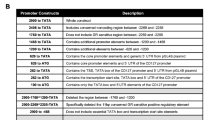Summary
This study examined the effect of IL-10 on immunoglobulin-like transcript (ILT4) expression of human monocytic leukemic cell line THP-1, especially the role of the ILT4 promoter activity. ILT4 promoter area was amplified by PCR, and was cloned into the eukaryotic expressing vector pGL3-Basic. The pGL3-ILTP obtained was tested by double endonuclease digestion and sequencing. Then, the recombinant plasmid was transfected into THP-1 cells by using lipofectamine. After culture with IL-10 for 12 h, the mRNA extracted from THP-1 cells was detected by RT-PCR and the protein was detected by FACS. The dual-luciferase reporter assay system was employed to detect the activity of ILT4 promoter with or without IL-10. The results showed that the activity of pGL3-ILTP was significantly increased and was more than ten times that of pGL3-Basic cells. After culture with IL-10 for 12 h, the expression of ILT4 protein and its mean fluorescence intensity (MFI) were increased. Moreover, the mRNA was remarkably higher than that of the control group. Dual-luciferase reporter assay revealed that ILT4 promoter was much more activated after being treated with IL-10. We were led to conclude that pGL3-ILTP containing ILT4 promoter was constructed successfully. The expression of ILT4 could be up-regulated by IL-10 both at the transcriptional and translational level. Furthermore, ILT4 promoter could be much more active after addition of IL-10. This study suggests that IL-10 up-regulates ILT4 expression on monocytes via increasing ILT4 gene promoter activity, which may have implication for inducing transplantation tolerance in clinical practice.
Similar content being viewed by others
References
Jiang S, Lechler RI, He XS, et al. Regulatory T cells and transplantation tolerance. Hum Immunol, 2006,67(10): 765–776
Cortesini R, Suciu-Foca N. ILT3+ ILT4+ tolerogenic endothelial cells in transplantation. Transplantation, 2006, 82(1 Suppl):S30–S32
Ureta G, Osorio F, Morales J, et al. Generation of dendritic cells with regulatory properties. Transplant Proc, 2007, 39(3):633–637
Yanagawa Y, Onoe K. Enhanced IL-10 production by TLR4- and TLR2-primed dendritic cells upon TLR restimulation. J Immunol, 2007,178(10):6173–6180
Chui CS, Li D. Role of immunolglobulin-like transcript family receptors and their ligands in suppressor T-cell-induced dendritic cell tolerization. Hum Immunol, 2009,70(9):686–691
Li D, Wang L, Yu L, et al. Ig-like transcript 4 inhibits lipid antigen presentation through direct CD1d interaction. J Immunol, 2009,182(2):1033–1040
Isakov N. ITIMs and ITAMs: The Yin and Yang of antigen and Fc receptor-linked signaling machinery. Immunol Res, 1997,16(1):85–100
Vlad G, Cortesini R, Suciu-Foca N. CD8+ T suppressor cells and the ILT3 master switch. Hum Immunol, 2008, 69(11):681–686
Suciu-Foca N, Cortesini R. Central role of ILT3 in the T suppressor cell cascade. Cell Immunol, 2007,48(1):59–67
Papanikolaou NA, Vasilescu ER, Suciu-Foca N. Novel single nucleotide polymorphisms in the human immune inhibitory immunoglobulin-like T cell receptor type 4. Hum Immunol, 2004,65(7):700–705
Shiroishi M, Tsumoto K, Amano K, et al. Human inhibitory receptors Ig-like transcript 2 (ILT2) and ILT4 compete with CD8 for MHC class I binding and bind preferentially to HLA-G. Proc Natl Acad Sci USA, 2003, 100(15):8856–8861
Portillo JA, Okenka G, Kern TS, et al. Identification of primary retinal cells and ex vivo detection of proinflammatory molecules using flow cytometry. Mol Vis, 2009,15:1383–1389
Vlad G, Piazza F, Colovai A, et al. Interleukin-10 induces the upregulation of the inhibitory receptor ILT4 in monocytes from HIV positive individuals. Hum Immunol, 2003,64(5):483–489
Wu J, Horuzsko A. Expression and function of immunoglobulin-like transcripts on tolerogenic dendritic cells. Hum Immunol, 2009,70(5):353–356
Nakajima H, Samaridis J, Angman L, Colonna M. Human myeloid cells express an activating ILT receptor (ILT1) that associates with Fc receptor gamma-chain. J Immunol, 1999;162(1):5–8
Cella M, Döhring C, Samaridis J, et al. A novel inhibitory receptor (ILT3) expressed on monocytes, macrophages, and dendritic cells involved in antigen processing. J Exp Med, 1997,185(10):1743–1751
Yamazaki S, Inaba K, Tarbell KV, et al. Dendritic cells expand antigen-specific Foxp3+ CD25+ CD4+ regulatory T cells including suppressors of alloreactivity. Immunol Rev, 2006,212:314–329
Chang CC, Ciubotariu R, Manavalan JS, et al. Tolerization of dendritic cells by T(S) cells: the crucial role of inhibitory receptors ILT3 and ILT4. Nat Immunol, 2002,3(3):237–243
Manavalan JS, Rossi PC, Vlad G, et al. High expression of ILT3 and ILT4 is a general feature of tolerogenic dendritic cells. Transpl Immunol. 2003,11(3–4):245–258
Ristich V, Zhang W, Liang S, et al. Mechanisms of prolongation of allograft survival by HLA-G/ILT4-modified dendritic cells. Hum Immunol, 2007,68(4): 264–271
Fontenot JD, Gavin MA, Rudensky AY. Foxp3 programs the development and function of CD4+ CD25+ regulatory T cells. Nat Immunol, 2003,4(4):330–336
Vignali DA, Collison LW, Workman CJ. How regulatory T cells work. Nat Rev Immunol, 2008,8(7):523–532.
Gleissner CA, Dengler TJ. Induction of ILT expression on nonprofessional antigen presenting cells: Clinical applications. Hum Immunol, 2009,70(5):357–359
Wang Y, Zhuang Q, Zhou S, et al. Costimulatory molecule B7-H1 on the immune escape of bladder cancer and its clinical significance. J Huazhong Univ Sci Technol [Med Sci], 2009,29(1):77–79
Hu S, Xiao W, Kong F, et al. Regulatory T cells and their molecular markers in peripheral blood of the patients with systemic lupus erythematosus. J Huazhong Univ Sci Technol [Med Sci], 2008,28(5):549–552
Author information
Authors and Affiliations
Corresponding author
Additional information
The two authors contributed equally to this work.
This project was supported by grants from National Natural Sciences Foundation of China (No.30571755) and Specialized Research Fund for the Doctoral Program of Higher Education (No.200804871175).
Rights and permissions
About this article
Cite this article
Xu, X., Zou, P., Chen, L. et al. IL-10 enhances promoter activity of ILT4 gene and up-regulates its expression in THP-1 cells. J. Huazhong Univ. Sci. Technol. [Med. Sci.] 30, 594–598 (2010). https://doi.org/10.1007/s11596-010-0548-8
Received:
Published:
Issue Date:
DOI: https://doi.org/10.1007/s11596-010-0548-8




